June 16, 2025 | 00:28 GMT +7
June 16, 2025 | 00:28 GMT +7
Hotline: 0913.378.918
June 16, 2025 | 00:28 GMT +7
Hotline: 0913.378.918
Growing rice in sandworm fields in Hai Phong and some Northern coastal localities has been applied for centuries, when people began to cultivate agriculture in fertile lands outside the dyke.
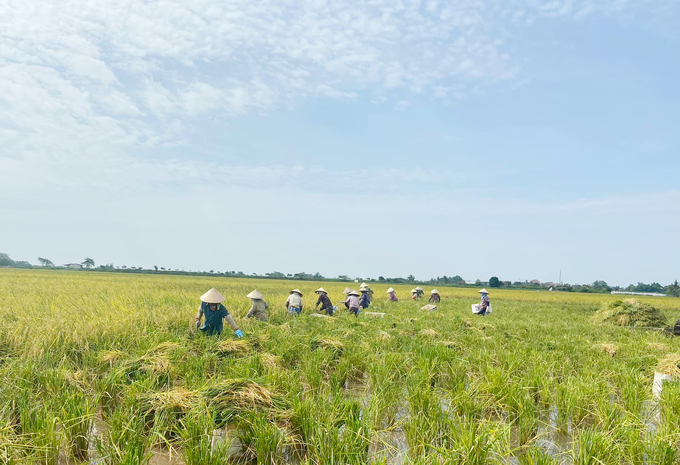
Hundreds of hectares of rice-sandworm fields in Ngu Phuc commune, Kien Thuy district. Photo: Dinh Muoi.
Growing rice in sandworm fields requires meticulousness and high farming techniques. During each production crop, farmers often take care of rice by monitoring its growth and adjusting the amount of water accordingly.
It is worth noting that sandworms are very sensitive to environmental changes and need high humidity and adequate light for optimal development. To be able to raise sandworms and grow rice at the same time, people are forced to research farming methods that do not affect the "very clean" growth and development of sandworms while still ensuring nutrition and disease safety for rice plants.
Hai Phong currently has more than 1,200 hectares of fields outside the dyke, distributed mainly in Tien Lang, Kien Thuy, Vinh Bao, and An Lao districts. Previously, local people often renovated these areas to raise sandworms and sold them at prices of VND 300,000–450,000/kg.
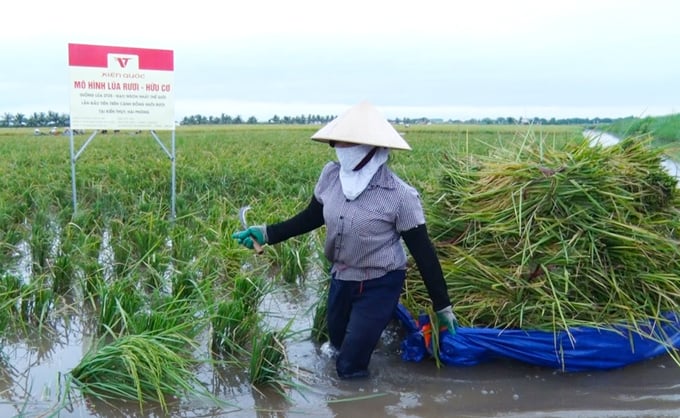
Harvesting rice grown in sandworm fields. Photo: Dinh Muoi.
With such market prices, from just 1 acre of cultivation, people can earn tens of millions of dong. Sandworms bring extremely high economic benefits, so for many years, few people have paid attention to intensively cultivating rice or other crops in this area. Or they grew rice just to create a growing environment for sandworms without paying too much attention to rice productivity.
About 5 years ago, as life developed and the number of sandworms gradually decreased under the influence of humans, people planted more rice and added chicken manure to the field to create a favorable living environment for sandworms. The combination between rice farming and sandworm raising not only helps increase rice productivity but also creates a balanced ecological environment.
After each harvest, the output of sandworms not only increases, but people also harvest tons of "specialty" rice and sell it at prices many times higher than the market price. On the same unit of area, in the past, only one type of specialty was obtained, but now people have more revenue, and everyone is excited.
Just like that, one person spread the word to the other, and a series of rice-sandworm production models were formed, bringing dual benefits to farmers with production fields outside the dyke.

People both raise sandworms and grow rice, so they can harvest two specialties at the same time. Photo: Dinh Muoi.
"Due to the characteristics of the sandworm species, rice grown in sandworm fields is completely free of chemical fertilizers and pesticides. Growth conditions are completely natural organic compounds. Selected rice varieties are naturally healthy. Therefore, rice is favored by the market," said Mr. Luong Van Ken, a rice-sandworm growing household in Ngu Phuc commune, Kien Thuy district, Hai Phong city.
Since the development of rice farming in sandworm fields in Hai Phong, realizing the potential and great profits from sandworm fields in Hai Phong, many businesses have coordinated directly with people to produce specialty rice types to supply to the market.
One of the pioneers investing in rice-sandworm models in Hai Phong can be mentioned as Mr. Tran Van Trung, Director of Hai Au Viet Investment Joint Stock Company, or Ms. Nguyen Thi Ha, Director of Thuy Huong Agricultural Service Cooperative.
These are units directly linking with households with sandworm fields to support seeds, agricultural materials, and output consumption for rice products in sandworm fields in Ngu Phuc and Kien Quoc communes. Both have large raw material areas and create brands that are typical agricultural products of Hai Phong city.
Mr. Tran Van Trung, Director of Hai Au Viet Investment Joint Stock Company, said that the rice-sandworm production model, which transplants rice varieties with high yields and delicious rice grains, has spread to many rice-sandworm farming areas in Hai Phong. In addition to money from selling sandworms, many families earn billions of dong per crop by selling rice in sandworm fields.
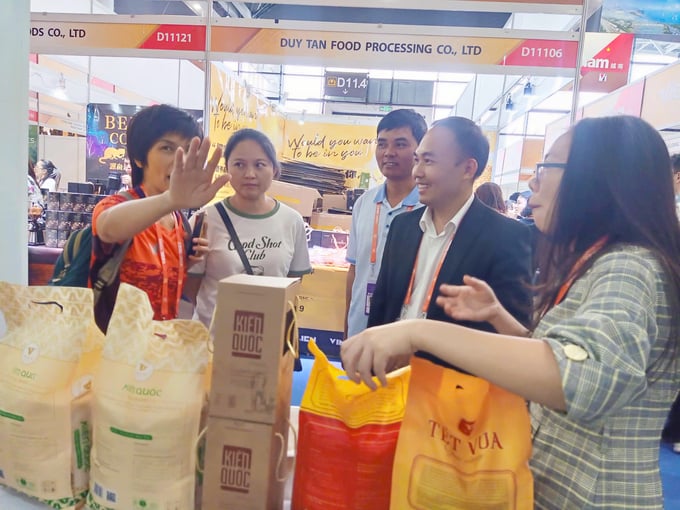
Mr. Tran Van Trung brought the organic rice product "Kien Quoc Sandworm Rice" to a trade fair in China, which was favored by many customers. Photo: Dinh Muoi.
Passionate about this agricultural product, Mr. Trung spent time researching and learning, went to Thailand many times, and then came to Soc Trang to meet engineer Ho Quang Cua, the "Father" of fragrant rice varieties ST24 and ST25 that are the world's delicious rice, to learn from experience and find delicious rice varieties for Hai Phong's fields.
"Rice grown in sandworm fields is favored by consumers because of the special farming conditions. Specifically, people are forced not to use any chemical fertilizers or pesticides. With such a process, the price of rice grown in sandworm fields is often many times higher than that of regular rice types but still not enough to sell," shared Mr. Tran Van Trung.
Also according to Mr. Tran Van Trung, recently, when attending the fair "Vietnam-China Business Trade Connection" held in Beijing, the organic rice product "Kien Quoc Sandworm Rice" was highly appreciated and recommended for cooperation by international traders and customers.
"Foreign partners and supermarkets really like our sandworm rice product and proposed to cooperate to sell it in their country's market at a price four times higher than the Vietnamese market. We are perfecting procedures according to international standards to bring rice products grown in sandworm fields to reach far," said Mr. Tran Van Trung.
According to experts, sandworm rice is not only delicious but also good for health because it contains many nutrients, vitamins, and minerals necessary for the body. Furthermore, sandworm rice is also said to be easy to digest, suitable for both children and the elderly, so the demand for sandworm rice is increasing.
In the future, not only Vietnam, but sandworm rice also has the potential to be exported to international markets. Finding trade partners and participating in international food fairs will be good opportunities to promote the image and quality of sandworm rice to the world.
Translated by Thu Huyen
/2025/06/12/3721-2-202745_83.jpg)
(VAN) TH made an impression at Seoul Food 2025 with its line of natural beverages, paving the way for Vietnamese food products to enter the South Korean market.
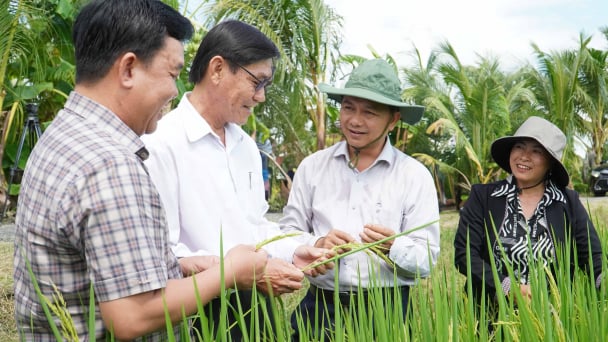
(VAN) Soc Trang's success in rice exports stems from a strategy of developing fragrant and specialty rice cultivation areas and standardizing production toward low-emission practices.
/2025/06/11/1311-5-120811_839.jpg)
(VAN) The pig farming industry is facing the challenge of comprehensive restructuring to meet requirements for quality, safety, traceability, and market expansion both domestically and for export.

(VAN) Vietnam considers participating in ALGROALBA in order to expand agricultural production, coordinate the assessment and effective exploitation potential land.
/2025/06/05/5314-1-184727_407.jpg)
(VAN) From seemingly worthless fish scales and skin, enzymes and lactic ferments can transform by-products into peptides, opening a sustainable, effective business direction and elevating Vietnamese seafood.
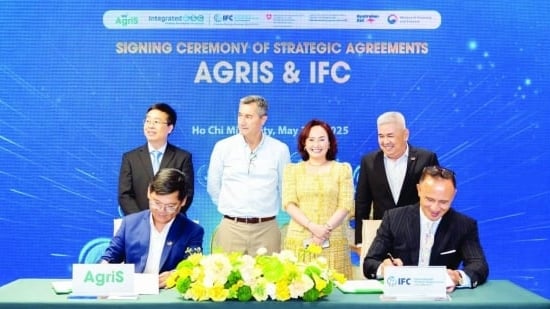
(VAN) TTC AgriS and IFC signed a strategic partnership to develop a sustainable agricultural value chain, aiming to achieve the Net Zero target by 2035.
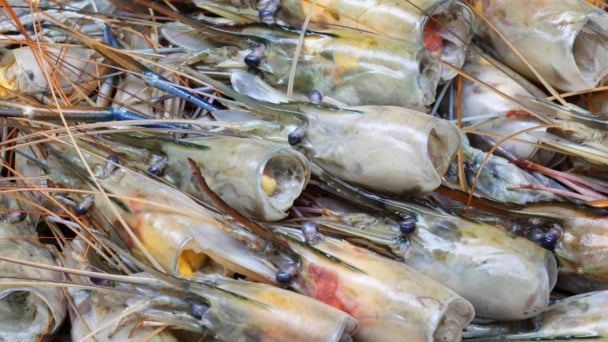
(VAN) Seafood by-products are opening a new path, combining green growth and technological innovation to enhance the industry's value.